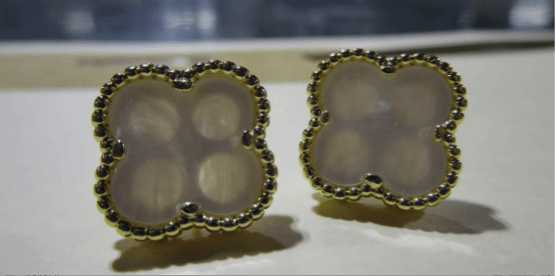The counterfeit Van Cleef & Arpels jewels would have been worth more than $30 million if genuine.

Louisville, Ky.—U.S. Customs and Border Protection (CBP) officers in Louisville, Kentucky, recently seized a shipment of more than 7,300 pairs of fake Van Cleef & Arpels earrings.
The jewels would have been worth nearly $30.4 million if genuine.
The shipment arrived from Hong Kong on Aug. 6 and was heading to a residence in Miami.
Officers inspected the shipment, which weighed 56 pounds and claimed to be a “metal necklace.”
Inside, they found 7,319 pairs of earrings made to look like they were from Van Cleef and Arpels’ “Alhambra” collection.
CBP’s Centers of Excellence and Expertise, the agency’s trade experts, determined they were fakes and violated the brand’s federally protected trademark.
“Legitimate trade powers the U.S. economy, but counterfeit and pirated goods dampen our economic successes, fund criminal networks, and threaten consumer trust and safety,” said LaFonda D. Sutton-Burke, director of field operations, at CBP’s Chicago field office.
“As consumers increasingly purchase from online or third-party vendors, our officers are at the frontline to guard against defrauders expecting to make money selling fake merchandise.”
In April, CBP officers in El Paso, Texas, seized 2,000 pieces of counterfeit Van Cleef & Arpels jewelry, worth $9.2 million if genuine.
For the last three years, jewelry was the top commodity with the highest total MSRP (manufacturer’s suggested retail price) seized for intellectual property rights (IPR) infringement, followed by watches and then handbags and wallets.
China and Hong Kong are consistently the top two source countries for IPR seizures, said CBP, accounting for 90 percent of the total quantity seized in fiscal 2024.
The counterfeit goods are usually sold via underground outlets or on third-party e-commerce sites, said CBP, and many fund smugglers and members of organized crime.
Intellectual property theft is not a victimless crime, noted CBP, highlighting the impact on consumers, businesses, trademark holders, and manufacturers of legitimate products.
“While it may seem harmless to buy a knock-off purse, an inexpensive electronic device, or cheaper medication, these trade practices threaten the public's health and safety, the U.S. economy, and national security by introducing harmful and banned materials into counterfeit products and supporting illegal labor practices,” said the organization.
CBP offers an “E-Commerce Counterfeit Awareness Guide for Consumers” on its website as well as an online educational initiative to educate consumers about the dangers surrounding counterfeit goods.
✨ Want to explore more exclusive insights into the global diamond & jewelry industry?
👉 Visit aidi.org
